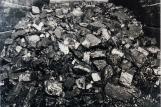2
The main entry to a coal mine. Coal-the energy source that gave rise to the city of Drumheller.Circa 1911
Drumheller, Alberta
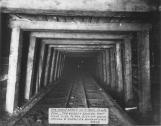 Credits:
Credits:Wayne Community Association
3
Who knew that the long hard road to prosperity and community lay at the end of a coal miner's pick?As with many prairie communities in the early 20th century, Drumheller's population consisted mostly of farmers, ranchers and homesteaders. Soon a young American entrepreneur named Jerome "Sam" Drumheller would arrive with a plan and an eye for industry. After acquiring a large chunk of land, it was Sam Drumheller's plan to set out a town site. In the following years the Canadian Northern Railway Company would pass through the valley and the town became his namesake.
4
Horses, driven by a child, turning hay20th Century
Drumheller, Alberta
 Credits:
Credits:Atlas Coal Mine Historical Society
5
Very early Drumheller, Whitehouse Hotel, train station, boxcars on track, Vickers Bros.1912 - 1922
Drumheller, Alberta
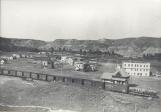 Credits:
Credits:Town of Drumheller
6
By 1912, the coal mining era of the Drumheller Valley was underway and coal production continued to increase. By 1921, there were 27 operating mines employing 2000 men and some were producing as much as 1.5 million tons of coal a year.7
Panoramic view of early mine camp. Two headframes in background.20th Century
Drumheller, Alberta
 Credits:
Credits:Atlas Coal Mine Historical Society
8
Miners and pit ponies at Newcastle Mine entrance. Note teapot oil cap lamps.1912
Drumheller, Alberta
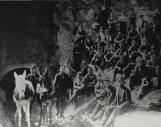 Credits:
Credits:Atlas Coal Mine Historical Society
9
Two miners standing in cage waiting to be lowered into shaft at the Miller Mine1924
Wayne, Alberta
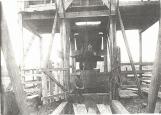 Credits:
Credits:Town of Drumheller
10
The beginning of the coal mining industry in Alberta brought about legislation regulating hours of work per day and working conditions. During the early 20th century, the hours for coal miners and most trades were limited to eight hours a day and has been this way ever since. As for the age of workers, children and women have been prohibited from working underground since 1898. However, the age that separates childhood from adulthood is not mentioned.1912 saw the employment of children under the age of 14 prohibited during school hours, except in certain circumstances. After school hours on the other hand, were free reign, and many young men were employed during this time.
12
Biz Griffin at Monarch #2 riding trolley locomotive1941
East Coulee, Alberta
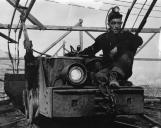 Credits:
Credits:Atlas Coal Mine Historical Society
13
And so the life of a miner begins!
14
Atlas Coal Mine Tipple20th Century
East Coulee, Alberta
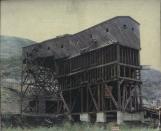 Credits:
Credits:Atlas Coal Mine Historical Society

